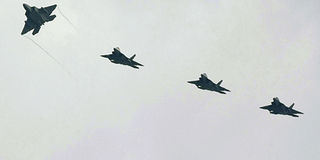US deploys 12 jets to Japan amid tensions

US Air Force F-22 Raptor fighter jets fly over Kadena U.S. Air Force base on Okinawa on Saturday. The first of 12 high-tech US F-22 fighter jets landed on the southern Japanese island of Okinawa days after North Korea unnerved the region by detonating a nuclear device. Photo/REUTERS
KADENA, Saturday
The first of 12 high-tech US F-22 fighter jets landed on the southern Japanese island of Okinawa today, days after North Korea unnerved the region by detonating a nuclear device. The arrival of state-of-the-art aircraft at Kadena air force base comes after US President Barack Obama reassured Prime Minister Taro Aso in a telephone conversation this week of Washington’s commitment to the defence of its Asian ally.
“The deployment underscores the US commitment to Japan as a vital regional partner and signals US resolve to ensure stability and security throughout the Pacific region,” the US Air Force said in a statement yesterday. North Korea fired a series of short-range missiles following its nuclear test and reports today said it appeared to be preparing to launch a long-range missile.
Anxiety over Pyongyang’s intentions has sparked calls for Japan to develop the capability to strike at enemy bases in the event of an imminent attack, despite its pacifist constitution. North Korea is also preparing to move an intercontinental ballistic missile from a factory near Pyongyang to a launch site on the east coast, a South Korean newspaper quoted a source in Washington as saying today.
US Secretary of Defence Robert Gates, speaking at a forum in Singapore, warned today that provocations by the communist state would not go unanswered. “We will not stand idly by as North Korea builds the capability to wreak destruction on any target in the region or on us,” Mr Gates told a meeting of Asian defence ministers in Singapore. “We will not accept North Korea as a nuclear state.”
Increasingly belligerent North Korea has warned of war on the Korean peninsula, saying it was no longer bound by an armistice that ended the 1950-53 Korean War and threatened further provocations in response to UN Security Council censure.
The factory north of Pyongyang is the same place where the North manufactured the long-range rocket it fired on April 5 before moving it to the east-coast Musudan-ri missile range for assembly and launch, the Dong-a Ilbo newspaper said.




